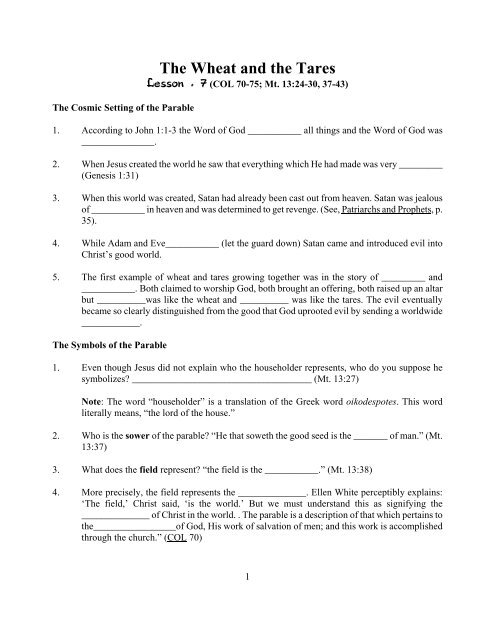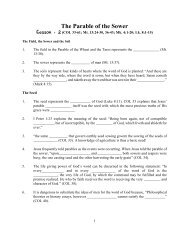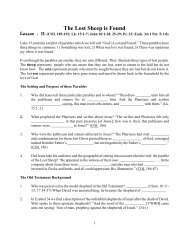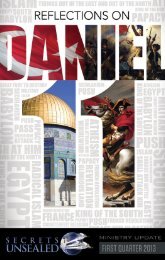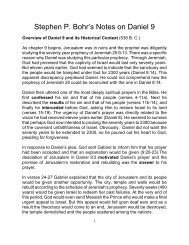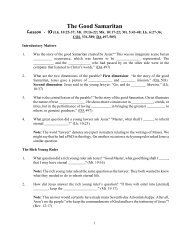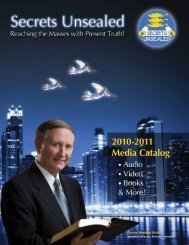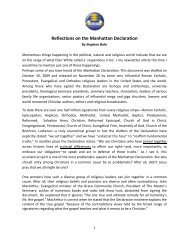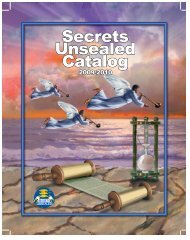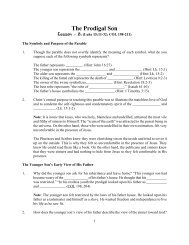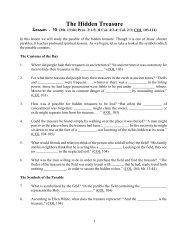The Wheat and the Tares - Secrets Unsealed > Home
The Wheat and the Tares - Secrets Unsealed > Home
The Wheat and the Tares - Secrets Unsealed > Home
Create successful ePaper yourself
Turn your PDF publications into a flip-book with our unique Google optimized e-Paper software.
<strong>The</strong> Cosmic Setting of <strong>the</strong> Parable<br />
<strong>The</strong> <strong>Wheat</strong> <strong>and</strong> <strong>the</strong> <strong>Tares</strong><br />
Lesson # 7 (COL 70-75; Mt. 13:24-30, 37-43)<br />
1. According to John 1:1-3 <strong>the</strong> Word of God ___________ all things <strong>and</strong> <strong>the</strong> Word of God was<br />
_______________.<br />
2. When Jesus created <strong>the</strong> world he saw that everything which He had made was very _________<br />
(Genesis 1:31)<br />
3. When this world was created, Satan had already been cast out from heaven. Satan was jealous<br />
of ___________ in heaven <strong>and</strong> was determined to get revenge. (See, Patriarchs <strong>and</strong> Prophets, p.<br />
35).<br />
4. While Adam <strong>and</strong> Eve___________ (let <strong>the</strong> guard down) Satan came <strong>and</strong> introduced evil into<br />
Christ’s good world.<br />
5. <strong>The</strong> first example of wheat <strong>and</strong> tares growing toge<strong>the</strong>r was in <strong>the</strong> story of _________ <strong>and</strong><br />
___________. Both claimed to worship God, both brought an offering, both raised up an altar<br />
but __________was like <strong>the</strong> wheat <strong>and</strong> __________ was like <strong>the</strong> tares. <strong>The</strong> evil eventually<br />
became so clearly distinguished from <strong>the</strong> good that God uprooted evil by sending a worldwide<br />
____________.<br />
<strong>The</strong> Symbols of <strong>the</strong> Parable<br />
1. Even though Jesus did not explain who <strong>the</strong> householder represents, who do you suppose he<br />
symbolizes? _____________________________________ (Mt. 13:27)<br />
Note: <strong>The</strong> word “householder” is a translation of <strong>the</strong> Greek word oikodespotes. This word<br />
literally means, “<strong>the</strong> lord of <strong>the</strong> house.”<br />
2. Who is <strong>the</strong> sower of <strong>the</strong> parable? “He that soweth <strong>the</strong> good seed is <strong>the</strong> _______ of man.” (Mt.<br />
13:37)<br />
3. What does <strong>the</strong> field represent? “<strong>the</strong> field is <strong>the</strong> ___________.” (Mt. 13:38)<br />
4. More precisely, <strong>the</strong> field represents <strong>the</strong> ______________. Ellen White perceptibly explains:<br />
‘<strong>The</strong> field,’ Christ said, ‘is <strong>the</strong> world.’ But we must underst<strong>and</strong> this as signifying <strong>the</strong><br />
______________ of Christ in <strong>the</strong> world. . <strong>The</strong> parable is a description of that which pertains to<br />
<strong>the</strong>_________________of God, His work of salvation of men; <strong>and</strong> this work is accomplished<br />
through <strong>the</strong> church.” (COL 70)<br />
1
5. What does <strong>the</strong> good seed symbolize? “<strong>the</strong> good seed are <strong>the</strong> children of <strong>the</strong> _____________”<br />
(Mt. 13:38)<br />
6. What do <strong>the</strong> tares represent? “<strong>the</strong> tares are <strong>the</strong> children of <strong>the</strong> ____________ one” (Mt. 13:38)<br />
Note: <strong>The</strong> Greek work for tares here is zizania. <strong>The</strong> reference here is probably to <strong>the</strong> lolium<br />
temulentum. “This common Palestinian plant grows about 2 ft. tall. In its earlier stages it is<br />
indistinguishable from wheat. Only when <strong>the</strong> plant matures <strong>and</strong> <strong>the</strong> seeds of <strong>the</strong> darnel turn<br />
black is it easy to tell <strong>the</strong> difference. <strong>The</strong>se seeds are poisonous, <strong>and</strong> if eaten, produce violent<br />
nausea, diarrhea, convulsions, <strong>and</strong> sometimes death.” (<strong>The</strong> Seventh-Day Adventist Bible<br />
Commentary, volume 5, p. 407).<br />
7. <strong>The</strong> tares more specifically represent false believers in <strong>the</strong> church: “By bringing into <strong>the</strong><br />
_____________ those who bear Christ’s ___________ while <strong>the</strong>y deny his _____________, <strong>the</strong><br />
wicked one causes that God shall be dishonored, <strong>the</strong> work of salvation misrepresented, <strong>and</strong><br />
souls imperiled.” (COL 71)<br />
8. Who is <strong>the</strong> enemy who sowed <strong>the</strong> tares? “<strong>the</strong> enemy that sowed <strong>the</strong>m [<strong>the</strong> tares] is <strong>the</strong><br />
_______________.” (Mt. 13:39)<br />
Note: <strong>The</strong> enemy’s sowing of tares was an act of revenge: “In <strong>the</strong> East, men sometimes took<br />
revenge upon an enemy by strewing his newly sown fields with <strong>the</strong> seeds of some noxious weed<br />
that, while growing, closely resembled wheat. Springing up with <strong>the</strong> wheat, it injured <strong>the</strong> crop<br />
<strong>and</strong> brought trouble <strong>and</strong> loss to <strong>the</strong> owner of <strong>the</strong> field. So it is from enmity to Christ that Satan<br />
scatters his evil seed among <strong>the</strong> good grains of <strong>the</strong> kingdom.” (COL 71).<br />
9. When does <strong>the</strong> harvest occur? “<strong>the</strong> harvest is <strong>the</strong> end of <strong>the</strong> ____________.” (Mt. 13:39)<br />
Note: In Greek <strong>the</strong>re are two main words which are translated in <strong>the</strong> King James Version as<br />
“world”. <strong>The</strong> first is kosmos which refers to <strong>the</strong> world in its material composition. <strong>The</strong> second is<br />
<strong>the</strong> word aeon which describes <strong>the</strong> world within its temporal framework. <strong>The</strong> word which is<br />
used in Mt. 13:39 is aeon <strong>and</strong> a better translation of it would be “<strong>the</strong> end of <strong>the</strong> age” (see also,<br />
Mt. 28:20 where <strong>the</strong> same word is used. Ellen White remarks:<br />
“<strong>The</strong> tares <strong>and</strong> <strong>the</strong> wheat are to grow toge<strong>the</strong>r until <strong>the</strong> harvest; <strong>and</strong> <strong>the</strong> harvest is <strong>the</strong> end of<br />
probationary time.” (COL 72).<br />
10. Who are <strong>the</strong> reapers of <strong>the</strong> parable? “<strong>the</strong> reapers are <strong>the</strong> _______________.” (Mt. 13:39)<br />
11. Thought question: Although Jesus did not directly interpret who <strong>the</strong> servants represent, who do<br />
you suppose <strong>the</strong>y symbolize? __________________________________________________<br />
2
12. Thought question: What do you suppose is represented by <strong>the</strong> sleeping of <strong>the</strong> servants?<br />
_____________________________________________________________________________<br />
____________________________________________________________________<br />
13. In terms of <strong>the</strong> book of Revelation, what do you think is represented by <strong>the</strong> act of binding up <strong>the</strong><br />
tares in bundles to be burned? (Hint: Revelation 14:9-11)__________________________<br />
_________________________________________________________________________<br />
14. What is meant by <strong>the</strong> expression “wailing <strong>and</strong> gnashing of teeth”? (Mt. 13:43) To answer this<br />
question study <strong>the</strong> following passages: Psalm 112:10; Mt. 13:50; 22:13; 24:51; 25:30; Lk.<br />
13:28)<br />
15. What parallel text refers to God’s people shining in <strong>the</strong> kingdom? “And <strong>the</strong>y that be _______<br />
shall ___________ as <strong>the</strong> brightness of <strong>the</strong> firmament; <strong>and</strong> <strong>the</strong>y that turn many to righteousness<br />
as <strong>the</strong> _________ for ever <strong>and</strong> ever.” (Daniel 12:3)<br />
<strong>The</strong> Central Lessons of <strong>the</strong> Parable<br />
1. Thought question: Why must <strong>the</strong> wheat <strong>and</strong> <strong>the</strong> tares be allowed to grow toge<strong>the</strong>r until <strong>the</strong><br />
harvest?______________________________________________________________________<br />
____________________________________________________________________<br />
2. Does <strong>the</strong> parable of <strong>the</strong> wheat <strong>and</strong> <strong>the</strong> tares make church discipline unnecessary?<br />
“Christ has plainly taught that those who persist in _________ sin must be separated from <strong>the</strong><br />
_____________, but He has not committed to us <strong>the</strong> work of judging character <strong>and</strong><br />
_______________. . . . Should we try to uproot from <strong>the</strong> church those whom we<br />
_____________ to be spurious Christians, we should be sure to make mistakes. Often we regard<br />
a ________________ subjects <strong>the</strong> very ones whom Christ is drawing to Himself.” (COL 71)<br />
3. <strong>The</strong>re were two dangers in trying to uproot <strong>the</strong> tares before <strong>the</strong> right time: “<strong>The</strong>re was danger of<br />
disturbing <strong>the</strong> roots of <strong>the</strong> __________, <strong>and</strong> destroying <strong>the</strong> young blades, if <strong>the</strong> weeds were<br />
rudely pulled from among <strong>the</strong>m; besides this, <strong>the</strong> tares so closely ______________ <strong>the</strong> grain,<br />
while growing, that it was hard to distinguish <strong>the</strong> one from <strong>the</strong> o<strong>the</strong>r.” (Ellen G. White, <strong>The</strong><br />
Spirit of Prophecy, volume 2, p. 247).<br />
4. Regarding <strong>the</strong> first of <strong>the</strong>se dangers, Ellen White remarks: “As <strong>the</strong> tares have <strong>the</strong>ir roots closely<br />
intertwined with those of <strong>the</strong> good grain, so false _______________ in <strong>the</strong> _______________<br />
may be closely linked with true disciples. <strong>The</strong> real character of <strong>the</strong>se ________________<br />
believers is not fully manifested. Were <strong>the</strong>y [false believers] to be separated from <strong>the</strong> church,<br />
o<strong>the</strong>rs might be caused to _____________, who but for this would have remained<br />
________________.” (COL 72).<br />
3
5. How has <strong>the</strong> teaching of this parable been illustrated in <strong>the</strong> way which God has dealt with <strong>the</strong><br />
heavenly angels? (COL 72)_______________________________________________________<br />
6. How was <strong>the</strong> teaching of this parable illustrated in <strong>the</strong> way which Jesus dealt with Judas? (Read,<br />
<strong>The</strong> Desire of Ages, p. 563) What would have happened if Jesus had uprooted Judas from <strong>the</strong><br />
very beginning of His ministry?<br />
_____________________________________________________________________________<br />
___________________________________________________________________<br />
7. What o<strong>the</strong>r unworthy persons in <strong>the</strong> early church illustrate <strong>the</strong> lessons of this parable? Reflect<br />
seriously upon <strong>the</strong> experience of each of <strong>the</strong>se persons. (COL 73)<br />
a) ____________<br />
b) ____________<br />
c) ____________<br />
8. In what way did <strong>the</strong> church of <strong>the</strong> Dark Ages try to uproot what it thought to be tares?<br />
“Notwithst<strong>and</strong>ing Christ’s warning, men have sought to uproot <strong>the</strong> tares. To punish those who<br />
were ______________ to be evildoers, <strong>the</strong> church has had recourse to <strong>the</strong> _________ power.<br />
Those who differed from <strong>the</strong> _______________ doctrines have been imprisoned, put to torture<br />
<strong>and</strong> death, at <strong>the</strong> instigation of men who _____________ to be acting under <strong>the</strong> sanction of<br />
Christ. But it is <strong>the</strong> spirit of _____________, not <strong>the</strong> Spirit of Christ, that inspires such acts.”<br />
(COL 74)<br />
9. When will <strong>the</strong> clear difference be seen between <strong>the</strong> wheat <strong>and</strong> <strong>the</strong> tares? “Sinners who make a<br />
pretension of ____________ mingle for a time with <strong>the</strong> true followers of Christ, <strong>and</strong> <strong>the</strong><br />
_______________ of Christianity is calculated to ______________ many; but in <strong>the</strong> harvest of<br />
<strong>the</strong> world <strong>the</strong>re will be no likeness between <strong>the</strong> good <strong>and</strong> evil. <strong>The</strong>n those who have<br />
____________ <strong>the</strong> ______________, but who have not joined _____________, will be made<br />
manifest.” (COL 74).<br />
10. What is of critical importance in determining each persons destiny? “________________ is as<br />
nothing in <strong>the</strong> scale. It is ______________ that decides destiny.” (COL 74)<br />
11. What can be said about those who wish to cleanse <strong>the</strong> church from sin <strong>and</strong> sinners before <strong>the</strong><br />
close of probation?<br />
“Has God no living church? He has a church, but it is <strong>the</strong> church _______________, not <strong>the</strong><br />
church ________________. We are sorry that <strong>the</strong>re are defective ______________, that <strong>the</strong>re<br />
are tares amid <strong>the</strong> wheat. . . . Although <strong>the</strong>re are evils existing in <strong>the</strong> _________________, <strong>and</strong><br />
will be until <strong>the</strong> end of <strong>the</strong> world, <strong>the</strong> church in <strong>the</strong>se _________ days is to be <strong>the</strong> light of <strong>the</strong><br />
world that is polluted <strong>and</strong> demoralized by sin. <strong>The</strong> church, enfeebled <strong>and</strong> defective, needing to<br />
be reproved, warned, <strong>and</strong> counseled, is <strong>the</strong> ___________ object upon earth upon which Christ<br />
bestows His _____________ regard.” (Ellen G. White, Testimonies to Ministers, pp. 45, 49)<br />
4


